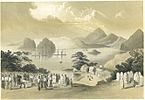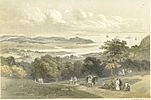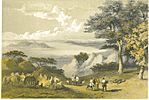Wilhelm Heine facts for kids
Peter Bernhard Wilhelm Heine, known as Wilhelm Heine, was a German-American artist, world traveler, and writer. He was also an officer during the American Civil War. He was born in Dresden on January 30, 1827, and passed away near Dresden on October 5, 1885.
Contents
Early Life and Art Studies
Wilhelm Heine grew up in Dresden. His father, Ferdinand Heine, was an actor at the Dresden Court Theatre. The famous composer Richard Wagner was a family friend.
Heine studied art at the Royal Academy of Arts in Dresden. He also learned from the artist Julius Hübner. Then, he spent three years studying art in Paris. After returning to Dresden, he worked as a designer for the court theater and taught painting. In 1849, he had to leave Dresden and move to New York. This was because he had taken part in the May Uprising in Dresden, a political event that was put down by force. Alexander von Humboldt, a famous explorer, helped him escape.
Adventures and Art Career
In New York, Heine opened his art studio. It was located at 515 Broadway. He quickly became known as a talented artist. He met Ephraim George Squier, an archaeologist and diplomat. Squier invited Heine to join him on a trip to Central America. Heine went ahead of Squier, collecting and drawing local plants and animals. He also took notes for books he planned to write.
Before Squier arrived, Heine even filled in as a consul. He helped create a trade agreement between Central American countries and the United States. He then took this agreement to Washington. While in Washington, he met President Millard Fillmore and Commodore Matthew C. Perry. Heine was chosen from many artists to be the official artist for Perry's important trip to Japan.
Exploring Japan with Commodore Perry
Heine joined Commodore Perry's expedition to Japan as an acting officer. He served on the ship USS Mississippi. During 1853 and 1854, Heine visited places like Okinawa, the Bonin Islands, Yokohama, Shimoda, and Hakodate. The city of Edo (now Tokyo) was closed to the Americans at that time. Heine would visit Edo later, in 1860, when he returned to Japan with a German expedition.
Heine made many drawings of the places and people he saw in Japan. His colleague, Eliphalet Brown Jr., took early photographs called daguerreotypes. These drawings and photos became the official pictures of the American expedition. They are still very important today because they show what Japan was like before many foreigners arrived.
After returning to New York in 1855, Heine published several books. One was a collection of prints called Graphic Scenes of the Japan Expedition. He also contributed 400 drawings to Perry's official report. His own travel story, Reiss um die Welt nach Japan, was very popular. It was quickly translated into French and Dutch.
More Expeditions and Travels
Heine went back to Prussia (part of modern-day Germany). There, he published a German translation of a US government report about expeditions to the seas around Japan, China, and Okhotsk. He also wrote Japan und Seine Bewohner. In these books, he encouraged the Prussian government to send more expeditions to Asia. He wanted them to go before the Americans became too strong there.
His ideas were taken seriously. While in Berlin, he was invited to join the Eulenberg Expedition as the official artist again. He also got paid to send reports back to a newspaper in Cologne. During this trip, he met Mikhail Bakunin in Yokohama. Bakunin was a famous Russian revolutionary who was returning to Europe after escaping from Siberia. In 1864, Heine published his major work, a large travel book about the East, called Eine Weltreise um die nördliche Hemisphare.
Serving in the American Civil War
When the American Civil War began, Heine, who was a Forty-Eighter (a German who had moved to America after the 1848 revolutions), returned to the US. He joined the Union Army to fight for the North. He first joined the 1st Regiment Maryland Volunteer Infantry. Later, he became a Captain in the United States Army Corps of Topographical Engineers. This meant he helped with mapping and planning for the army.
Heine served in the Army of the Potomac. He was captured during the Peninsula Campaign and held briefly in Libby Prison, a prison for soldiers. He was later exchanged. In late 1862, he faced some issues because people thought his drawings might have shown too much information about the Union's defenses. He was also wounded. He was honorably discharged, meaning he left the army with good standing, because he was "unfit for service."
However, in 1863, he rejoined the army. He became a Colonel of the 103rd New York Volunteer Infantry, a group made up mostly of German-Americans. He later commanded a larger group of soldiers called a brigade, and then a small division in the Army of West Virginia. In 1865, he was given the honorary rank of Brevet Brigadier General. But he faced accusations of not following orders and left the army again.
The next year, he became a US clerk at the consulates in Paris and Liverpool. After the German Empire was formed in Germany in 1871, he returned to Dresden. There, he wrote his last book about Japan, called Japan, Beiträge zur Kenntnis des Landes und seiner Bewohner.
Selected Works
- 1856 -- Graphic Scenes in the Japan Expedition. New York: G. P. Putnam & Company. OCLC 3095611
- 1856 -- Reise um die Erde nach Japan an Bord der Expeditions-Escadron unter Com. Perry den Jahren 1853, 54, und 55, unternommen im Auftrage der Regierung der Vereinigten Staaten. Leipzig: Hermann Costenoble.
- 1857 -- Wanderbilder aus Central-Amerika: Skizzen eines deutschen Malers (Walking pictures from Central America: Sketches of a German Painter). Leipzig: Hermann Costenoble.
- 1864 -- Eine Weltreise um die nördliche Hemisphäre in Verbindung mit der Ostasiatischen Expedition in den Jahren 1860 und 1861 (A voyage round the world around the Northern Hemisphere in Connection with the East Asian Expedition, 1860-1861). Leipzig: F.A. Brockhaus. OCLC 63836384
- 1865 -- Treasury of Travel and Adventure in North and South America, Europe, Asia and Africa: A Book for Young and Old. New York: D. Appleton and Company. OCLC 48859643
- 1871 -- Japan, Beiträge zur Kenntnis des Landes und seiner Bewohner (Japan, contribution to the knowledge of the country and its inhabitants). Berlin: P. Bette. OCLC 82741141
Images for kids





